
The present outbreak of the 2019 coronavirus strain (COVID19) constitutes a public health emergency of global concern. Symptoms of COVID-19 infection include fever, cough, and acute respiratory disease, with severe cases leading to pneumonia, kidney failure, and even death.
As stated by WHO only way one can control this pandemic and win this global the warlike situation is with 3 T’S i.e. Test, Test, and Test.
Therefore there is a need to increase investigations to the detection of COVID-19
● Novel coronavirus (COVID-19) has recently been identified in the saliva of infected patients and is associated with human-to-human transmission.
● Detection of coronavirus in oral fluids can play a crucial role in early, rapid and mass screening of individuals for coronavirus and can prove beneficial in improving the strategies for prevention, Saliva can have a pivotal role in the human-to-human transmission and non-invasive salivary diagnostics may provide a convenient and cost-effective point-of-care platform for the fast and early detection of COVID-19 infection.
● It has been suggested that there is a minimum of three different pathways for COVID-19 to present in saliva: firstly, from COVID-19 in the lower and upper respiratory tract that enters the oral cavity together with the liquid droplets frequently exchanged by these organs. Secondly, COVID-19 present in the blood can access the mouth via crevicular fluid, an oral cavity-specific exudate that contains local proteins derived from extracellular matrix and serum-derived proteins
● Finally, another way for COVID19 to occur in the oral cavity is by major- and minor-salivary gland infection, with subsequent release of particles in saliva via salivary ducts.
● Diagnosis of COVID-19 can theoretically be performed using salivary diagnosis platforms. Some virus strains have been detected in saliva as long as 29 days after infection indicating that a non-invasive platform to rapidly differentiate the biomarkers using saliva could enhance disease detection.
● Saliva sample collection needs to be done bearing in mind the requirement of close contact between healthcare workers and infected patients to collect nasopharyngeal or oropharyngeal samples, therefore it needs a trained professional who has expertise in sample collection from oral cavity as well as utmost knowledge of infection control. Professionals that are most suitable for this challenge are the Oral and Maxillofacial Pathologists.
● Oral and maxillofacial pathology is a specialized branch of dentistry that deals with diagnosing diseases in the head, neck, mouth (oral), or the jaws and face.
● Oral and maxillofacial pathology (OMP) is an important bridge between dentistry and medicine and oral pathologist are playing a crucial role in the fight against the coronavirus worldwide.